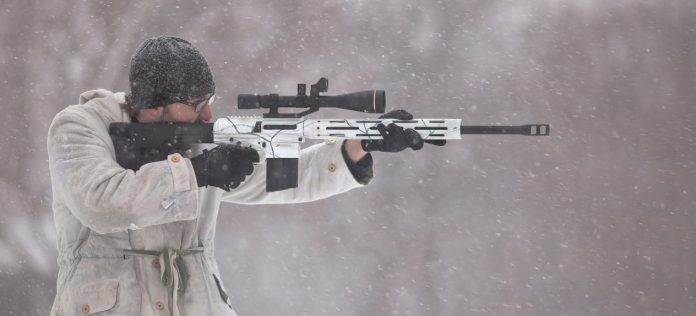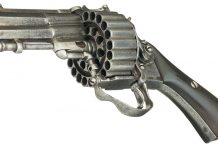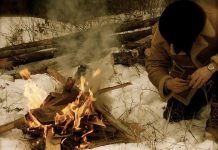Winter poses specific challenges for all and anything, especially when a “bombogenesis” is encountered. So, it is obviously important in any situation to have a functioning weapon. Ask the Marines as their weapons froze and ceased to work at the Chosin Reservoir. Troops have long known that special arms care is needed for harsh winters. You need to know how to tackle winter whether you’re a hunter, prepper, or worried about gun maintenance at all.
Related: 9 Items For The Winter Prepper Checklist
Step 1 – Some Lubes Suck
I won’t name names, but in the winter and fall, some lubricants simply don’t work well. Particularly the ones based on vegetable oils. These oils like to gum up when it gets cold and these lubricants are pretty useless before your weapon gets heated. So the first move is getting rid of these lubricants that are gummy. If you do not, you risk the failure of the firearm. It’s a real pain to clean this gunk out of the tiny crevices of your weapon, but it needs to be done.
Also, oil-based lubes will harden and become more of a blessing than a hassle. Lubes are intended to operate in extreme heat, you see. Weapons run hot, and lubricants are designed to operate within the heat realm and reduce the friction of metal parts between metals. They’re not supposed to last in cold weather … so they don’t.
Step 2 – Remove those Old Lubes
It’s not enough to just not use these lubes. As winter begins, you need to strip your weapons of every single bit of lube on them. Get an old t-shirt, cut it into pieces, and clean it up. Get as far as you can really get in and get the gunk out of there. You can operate a gun with very little lube, believe it or not. If you fire hundreds of rounds at a time, go ahead and lube your weapon before shooting. Only remember to go ahead and break the weapon down after using it and strip the lube out of the weapon.
Now, if you’re like me, it’s not possible that your hunting rifle would shoot a whole lot during the hunting season. It’s definitely not going to get dirty and shot too many times that I really need to think about lubrication. If you don’t fire hundreds or thousands of laps at a time, the cold weather outside will keep the gun from getting too hot.
Related: Emergency Care For Gunshot Wounds
Step 3 – Condensation is the Enemy a.k.a. the Most Important Cleaning Step
Here is the real risk when it comes to repairs for winter. Sit in a tree stand when you go out in the wind, or deer-blind stuff get wind. Your gun’s getting cold, you’re getting cold, the world’s getting cold. Then what are you doing? Are you warm? You’re going inside the house, the cabin, etc. Your beautiful, comfortable release from the cold outdoors. Your firearm is to and is experiencing condensation as you warm up.
What happens when you bring your gun in from the cold is condensation. The air holds moisture and the air can no longer carry moisture when it gets too cold. It builds up inside and outside the weapon and the moisture will materialize on the weapon and within the weapon as it gets warm. It’s not a good thing here.
There’s something very easy involved in the very best winter cleaning technique. Disassemble the firearm and dry it out with a piece of fabric. It is important to have this piece of cloth clean and free of lubricant. The inside and outside of the arms must be dried and you must ensure that you hold condensation at bay. You want to make it possible to get the outside, the inside and every single small piece. Within the first 5 minutes of bringing it into a warmer setting, you want to dry the gun.
Related: 15 Best Guns for Preppers
Step 4 – Don’t Forget the Ammo
One thing is keeping the gun clean, but you need to keep the ammunition clean and dry as well. You actually need to test your ammunition periodically. The slender design of brass ensures that it is easy to crack. Exposing thin metal to hot and then cold conditions can cause some cracking problems. In their cases, you can also expect primers to pop out and bullets to take a strange angle.
Inspect the ammunition, make sure it’s standard and rock and roll ready. Bad ammo could hurt your weapon, trigger a jam, or just click when you really, really need a bang. It is necessary to check and make sure your ammunition is not corroded or harmed. Wipe it down just like you’re wiping the pieces of your weapons.
Step 5 – Inspect, inspect and inspect
Make sure that every rifle that you hold in storage is winter prepared. Of course, it may not be a weapon that you use every day, or one that you use sometimes, but it should be prepared for winter. Clean away the lube and check the weapons for moisture or rust at least once a week. Take your time to check each firearm inside and outside. Taking 5 minutes to check and dry your arms will prevent you from scrubbing and rubbing off rust for hours.
Winter is Coming
For a lot of people, winter is a big deal, and it poses unique problems for gunmen. In general, hunters, recreational shooters and gun owners need to hit the ground running when it comes to the maintenance of winter weapons. Keep ahead of the curve, and be ready for the temperatures of snow, sleet, and subzero. Just remember step 3. Keep your gun dry!





















